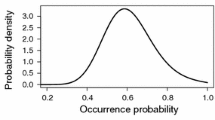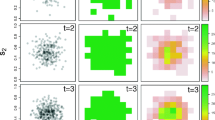Abstract
In this paper we emphasize that sampling decisions in population and community ecology are context dependent. Thus, the selection of an appropriate sampling procedure should follow directly from considerations of the objectives of an investigation. We recognize eight sampling alternatives, which arise as a result of three basic dichotomies: parameter estimation versus pattern detection, univariate versus multivariate, and a discrete versus continuous sampling universe. These eight alternative sampling procedures are discussed as they relate to decisions regarding the required empirical sample size, the selection or arrangement of sampling units, and plot size and shape. Our results indicate that the decision-making process in sampling must be viewed as a flexible exercise, dictated not by generalized recommendations but by specific objectives: there is no panacea in ecological sampling. We also point to a number of unresolved sampling problems in ecology.
Similar content being viewed by others
References
BarkmanJ. J. 1979. The investigation of vegetation texture and structure. In: WergerM. J. A. (ed.), The study of vegetation. pp. 125–160. Junk, The Hague.
BarthaS. & Horváth, 1987. Application of long transects and information theoretical functions to pattern detection. I. Transects versus isodiametric sampling units. Abstr. Bot. 11: 9–26.
BigwoodD. W. & InouyeD. W. 1988. Spatial pattern analysis of seed banks: an improved method and optimized sampling. Ecology 69: 497–507.
BormannG. E. 1953. The statistical efficiency of sample plot size and shape in forest ecology. Ecology 34: 474–487.
BourdeauP. F. 1953. A test of random versus systematic ecological sampling. Ecology 34: 499–512.
BouxinG. 1983. Multi-scaled pattern analysis: an example with savanna vegetation and a proposal for a sampling design. Vegetatio 52: 161–169.
Braun-BlanquetJ. 1964. Pflanzensoziologie. Grundzüge der Vegetationskunde. 3. Aufl. Springer, Wien.
CarpenterS. R. & ChaneyJ. E. 1983. Scale of spatial pattern: four methods compared. Vegetatio 53: 153–160.
CastroI., SterlingA. & GalianoE. F. 1986. Multi-species pattern analysis of Mediterranean pastures in three stages of ecological succession. Vegetatio 68: 37–42.
ClaphamA. R. 1932. The form of the observational unit in quantitative ecology. J. Ecol. 20: 192–197.
ClarkP. J. & EvansF. C. 1954. Distance to nearest neighbour as a measure of spatial relationships in populations. Ecology 35: 445–453.
CochranW. G. 1977. Sampling techniques. 3rd ed. J. Wiley & Sons, New York.
CoxT. F. & LewisT. 1976. A conditioned distance ratio method for analyzing spatial patterns. Biometrika 63: 483–491.
CroyC. D. & DixR. L. 1984. Notes on sample size requirements in morphological plant ecology. Ecology 65: 662–666.
DeVriesP. G. 1986. Sampling theory for forest inventory. Springer, Berlin.
DietvorstP., van derMaarelE. & van derPuttenH. 1982. A new approach to the minimal area of a plant community. Vegetatio 50: 77–91.
DigbyP. G. N. & KemptonR. A. 1987. Multivariate analysis of ecological communities. Chapman & Hall, London.
DiggleP. J. 1979a. Statistical methods for spatial point patterns in ecology. In: CormackR. M. & OrdJ. K. (eds), Spatial and temporal analysis in ecology. pp. 95–150. Inter. Coop. Publ. House, Burtonsville, USA.
DiggleP. J. 1979b. On parameter estimation and goodness-of-fit testing for spatial point patterns. Biometrics 35: 87–101.
DiggleP. J. & MatérnB. 1980. On sampling designs for the study of point-event nearest neighbour distributions in R2. Scand. J. Statist. 7: 80–84.
DiggleP. J. & terBraakC. J. F. 1982. Point sampling of binary mosaics in ecology. In: RannebyB. (ed.), Statistics in theory and practice. Essays in the honour of Bertil Matérn. pp. 107–122. Swedish Univ. Agric. Sci., Section of Forest Biometry, S-901 83, Umeå, Sweden.
Elliott, J. M. 1983. Some methods for the statistical analysis of samples of benthic invertebrates. Freshwater Biol. Assoc. Sci. Publ. 25.
FeketeG. & SzöcsZ. 1974. Studies on interspecific association processes in space. Acta Bot. Acad. Sci. Hungary 20: 227–241.
FinneyD. J. 1948. Random and systematic sampling in timber surveys. Forestry 22: 64–99.
FinneyD. J. 1950. An example of periodic variation in forest sampling. Forestry 23: 96–111.
FreeseF. 1961. Relation of plot size to variability: an approximation. J. Forestry 58: 679.
GalianoE. F. 1982. Pattern detection in plant populations through the analysis of plant-to-all-plants distances. Vegetatio 49: 39–43.
GalianoE. F. 1983. Detection of multi-species patterns in plant populations. Vegetatio 53: 129–138.
GalianoE. F. 1985. The small-scale pattern of Cynodon dactylon in Mediterranean pastures. Vegetatio 63: 121–127.
GauchH. G. 1982. Multivariate analysis of community data. Cambridge Univ. Press, Cambridge.
GibsonD. J. & Greig-SmithP. 1986. Community pattern analysis: a method for quantifying community mosaic structure. Vegetatio 66: 41–47.
GoffF. G. 1975. Comparison of species ordinations resulting from alternative indices of interspecific association and different number of included species. Vegetatio 31: 1–14.
GoodallD. W. 1952. Some considerations in the use of point quadrats for the analysis of vegetation. Aust. J. Sci. Res., Ser. B 5: 1–41.
GoodallD. W. 1961. Objective methods for the classification of vegetation. IV. Pattern and minimal area. Aust. J. Bot. 9: 162–196.
GoodallD. W. 1974. A new method for the analysis of spatial pattern by random pairing of quadrats. Vegetatio 29: 135–146.
GoodallD. W. & WestN. E. 1979. A comparison of techniques for assessing dispersion patterns. Vegetatio 40: 15–27.
GreenR. H. 1979. Sampling design and statistical methods for environmental biologists. J. Wiley & Sons, New York.
Greig-SmithP. 1952. The use of random versus contiguous quadrats in the study of the structure of plant communities. Ann. Bot. Lond. N.S. 16: 293–316.
Greig-SmithP. 1983. Quantitative plant ecology. 3rd ed. U. California Press, Berkeley.
HahnI. 1982. Einige Probleme der Probeentnahme bei der Schätzung der Arten und Individuendiversität. II. Eine mögliche Individuelzahnkorrektion. Bot. Közlem., Budapest 69: 59–70 (Hungarian with German summary).
HaselA. A. 1938. Sampling errors in timber surveys. J. Agric. Res. 57: 713–736.
HillM. O. 1973. The intensity of spatial pattern in plant communities. J. Ecol. 61: 225–235.
Juhász-NagyP. & PodaniJ. 1983. Information theory methods for the study of spatial processes and succession. Vegetatio 51: 129–140.
JustesenS. H. 1932. Influence of size and shape of plots on the precision of field experiments with potatoes. J. Agric. Sci. 22: 366–372.
KalamakarR. J. 1932. Experimental error and the field plot technique with potatoes. J. Agric. Sci. 22: 373–385.
KenkelN. C. 1988a. Pattern of self-thinning in jack pine: testing the random mortality hypothesis. Ecology 69: 1017–1024.
KenkelN. C. 1988b. Spectral analysis of hummock-hollow pattern in a weakly minerotrophic mire. Vegetatio 78: 45–52.
KershawK. A. 1961. Association and covariance analysis of plant communities. J. Ecol. 49: 643–654.
KnappR. (ed.) 1984. Sampling methods and taxon analysis in vegetation science. Junk, The Hague.
KulowD. L. 1966. Comparison of forest sampling designs. J. Forestry 64: 469–474.
KwiatkowskaA. J. & SymonidesE. 1986. Spatial distribution of species diversity indices and their correlation with plot size. Vegetatio 68: 99–102.
LaferrièreJ. E. 1987. A central location method for selecting random plots for vegetation surveys. Vegetatio 71: 75–77.
LudwigJ. A. & GoodallD. W. 1978. A comparison of paired- with blocked-quadrat variance methods for the analysis of spatial pattern. Vegetatio 38: 49–59.
LudwigJ. A. & ReynoldsJ. F. 1988. Statistical ecology. J. Wiley & Sons, New York.
MatthewsJ. A. 1978. An application of non-metric multidimensional scaling to the construction of an improved species plexus. J. Ecol. 66: 157–173.
MountfordM. D. 1961. On E. C. Pielou's index of non-randomness. J. Ecol. 49: 271–275.
Mueller-DomboisD. & EllenbergH. 1974. Aims and methods of vegetation ecology. J. Wiley & Sons, New York.
Noy-MeirI. & AndersonD. J. 1971. Multiple pattern analysis, or multiscale ordination: towards a vegetation hologram? In: PatilG. P., PielouE. C. & WatersW. E. (eds), Many species populations, ecosystems, and systems analysis. pp. 207–225. Penn. State U. Press, University Park, Pa.
Noy-MeirI., TadmorN. H. & OrshanG. 1970. Multivariate analysis of desert vegetation. I. Association analysis at various quadrat sizes. Israel J. Bot. 19: 561–591.
OrlóciL. 1978. Multivariate analysis in vegetation research. 2nd ed. Junk, The Hague.
PechanecJ. F. & StewartG. 1940. Sagebrush-grass range sampling studies: size and structure of sampling units. J. Amer. Soc. Agron. 32: 669–682.
PielouE. C. 1959. The use of point-to-plant distances in the study of the pattern of plant populations. J. Ecol. 47: 607–613.
PielouE. C. 1962. The use of plant-to-neighbour distances for the detection of competition. J. Ecol. 50: 357–367.
PielouE. C. 1977. Mathematical ecology. J. Wiley & Sons, New York.
PodaniJ. 1984a. Spatial processes in the analysis of vegetation: theory and review. Acta Bot. Hung. 30: 75–118.
PodaniJ. 1984b. Analysis of mapped and simulated vegetation patterns by means of computerized sampling techniques. Acta Bot. Hung. 30: 403–425.
PodaniJ. 1986. Comparison of partitions in vegetation studies. Abst. Bot. 10: 235–290.
PodaniJ. 1987. Computerized sampling in vegetation studies. Coenoses 2: 9–18.
PrenticeI. C. & WergerM. J. A. 1985. Clump spacing in a desert dwarf shrub community. Vegetatio 63: 133–139.
Ram BabuM., AgarwalC. & PuriD. N. 1981. Size and shape of plots and blocks for field experiments in natural grasslands in Agra ravines. Indian J. Agric. Sci. 51: 271–275.
RenshawE. & FordE. D. 1984. The description of spatial pattern using two-dimensional spectral analysis. Vegetatio 56: 75–85.
RipleyB. D. 1977. Modelling spatial pattern. J. Royal Stat. Soc., Series B 39: 172–212.
RipleyB. D. 1981. Spatial statistics. J. Wiley & Sons, New York.
ScagelR., el-KassabyY. A. & EmanuelJ. 1985. Assessing sample size and variable number in multivariate data, with specific reference to cone morphology variation in a population of Picea sitchensis. Can. J. Bot. 63: 232–241.
SmarttP. F. M. 1978. Sampling for vegetation survey: a flexible systematic model for sample location. J. Biogeogr. 5: 43–56.
SmarttP. F. M. & GraingerJ. E. A. 1974. Sampling for vegetation survey: some aspects of the behaviour of unrestricted and stratified techniques. J. Biogeogr. 1: 193–206.
SukhatmeP. V., SukhatmeB. V., SukhatmeS. & AsokC. 1984. Sampling theory of surveys with applications. Iowa State Univ. Press, Ames.
UptonG. J. G. & FingletonB. 1985. Spatial data analysis by example. Vol. 1. Point pattern and quantitative data. J. Wiley & Sons, New York.
VanDyneG. M., VogelW. G. & FisserH. G. 1963. Influence of small plot size and shape on range herbage production estimates. Ecology 44: 746–759.
WiegertR. G. 1967. The selection of an optimum quadrat size for sampling the standing crop of grasses and forbs. Ecology 43: 125–129.
WilksS. S. 1962. Mathematical statistics. J. Wiley & Sons, New York.
WoldaH. 1981. Similarity indices, sample size and diversity. Oecologia 50: 296–302.
YandleD. O. & WyantH. V. 1981. Comparison of fixed-radius circular plot sampling with simple random sampling. Forest Sci. 27: 245–252.
Author information
Authors and Affiliations
Rights and permissions
About this article
Cite this article
Kenkel, N.C., Juhász-Nagy, P. & Podani, J. On sampling procedures in population and community ecology. Vegetatio 83, 195–207 (1989). https://doi.org/10.1007/BF00031692
Accepted:
Issue Date:
DOI: https://doi.org/10.1007/BF00031692




